Understanding how bullets are constructed for each handgun shooting application is important background information for proper bullet selection, and to understand how the reloading process works.
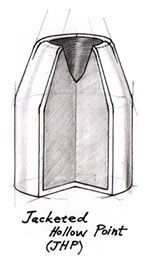
Construction
There are three basic types of bullet construction commonly used in handguns:
- Lead: Bullets that are solid lead. These bullets are cast, and offer specific ballistic characteristics, usually are lowest in cost, and are lubricated with a grease type of lubrication.
- Jacketed: Bullets that have a lead core, but also feature an outer jacket (usually copper) that engages with the rifling in the barrel of the handgun. These bullets cost more, can have greater accuracy, eliminate barrel leading (but do foul the barrel to some extent), and are approved for indoor use at local gun ranges.
- Other: Other types of bullets include plated bullets (thin metal coating), solid copper bullets, polymer coated bullets, and more.
An assortment of bullets, from left: Plated FP, Lead SWC, Lead RN, JSP, JHP, Jacketed RN
Read on to learn what these acronyms mean.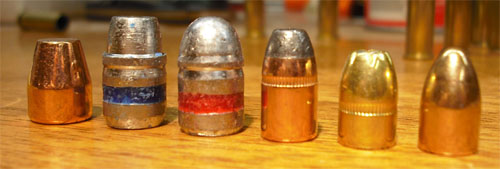
Application
There are two classifications for handgun bullets:
Automatic pistol bullets
Bullets for automatic pistols are typically plated or jacketed in composition. These bullets are also smooth on the sides, without special features for crimping. These bullets are held in place by neck tension (the press fit of the bullet into the case mouth, which is smaller in diameter). The shape of the bullet is optimized for reliable feeding.
Diagram: Automatic Pistol Bullet (Flat Point shown)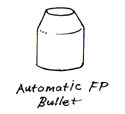
Revolver Bullets
Bullets for revolvers are commonly either lead, or jacketed in composition. Revovler bullets have more variety than automatic pistol bullets because they do not feed from a magazine, and therefore have fewer constraints in composition or shape. Revolver bullets are held in place by a combination of neck tension, and a “roll crimp” where the mouth of the case is rolled over into the crimp groove (lead bullets) or the cannellure (jacketed bullets). Lead bullets have a band of lubricant around the sides to prevent leading of the barrel.
Diagram: Revolver Bullets
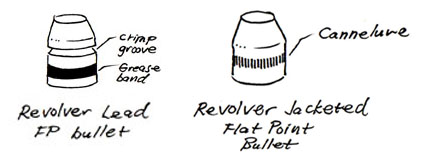
Types of Bullets
There are many different types of bullets that each have a unique set of characteristics, and an intended use for each as well. Here, I’ll describe different types of bullets based on their fundamental shape and properties. Since acronyms are typically used to describe bullets (Such as RNFP for Round Nose Flat Point) I’ll cover the most commonly types of bullets, and leave it to the reader to understand other permutations of these terms.
Wadcutter (WC)
The wadcutter is perhaps the most basic bullet profile. Typically made from lead, these bullets are basically a cylinder of lead. These bullets produce clean “punches” in paper targets.
Semi-Wadcutter (SWC)
The semi-wadcutter is a variation on the wadcutter. This bullet has a cylindrical body with a shoulder, and a flat point on the tip. These rounds offer better ballistic performance (less drag) than wadcutters, still punch nice holes in paper targets, and can be fed by automatic pistols in most cases.
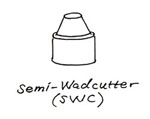
Flat Point (FP)
Flat point bullets generally have a flat point on the tip, and a straight taper from the body to the tip. These bullets feed well in automatics, and punch a small hole in targets (the diameter of the flat point).
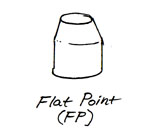
Round Nose (RN)
Round nose bullets have a cylindrical body with a round tip. These bullets offer the best feeding characteristics for automatic pistols (Think ball 45acp ammo from WWI+, and 9mm parabellum) and good ballistic characteristics as well. These bullets do not punch clean holes in targets, and are not good for hunting and defense.
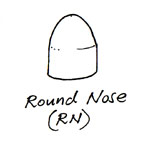
Round Nose Flat Point (RNFP)
This bullet is a cross between the Flat Point (FP) and the Round Nose (RN) bullet with characteristics similar to the Flat Point (FP) bullet.
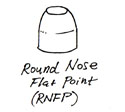
Soft Point (SP)
Jacketed Soft Point (SP) bullets are a jacketed bullet with an exposed lead tip. These bullets offer the benefits of fully jacketed bullets, but with increased stopping power due to the enhanced expansion becuase of the soft tip.
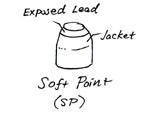
Hollow Point (HP)
These bullets feature a hole in the tip which greatly enhances expansion and corresponding stopping power.
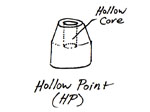
Bevel Base and Plain Base Bullets
Another important characteristic of bullet shape is the base profile. Jacketed and plated bullets typically have a plane (flat) base. Lead bullets can employ a plain base (for increased accuracy) or a bevel base (to minimize lead shaving while seating, and to enhance bullet placement).
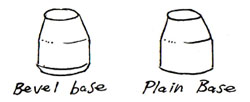
There you have it! The basics of handgun bullets. There’s much more to know, but this is enough to get one started in the reloading process. We’ll cover some of these topics in more detail in specific articles about reloading, bullet product reviews, etc.
Besides being interesting, the information behind the different types of bullets is vital for specific careers, like law enforcement and forensic detectives. These professionals rely on this knowledge when determining exactly what happened at a given scene. A masters in forensic psychology will allow a person the opportunity to dig deeper in this field and learn whether or not they are cut out for it.
Next: Pistol Primers
Originally published 01/2009

















































































